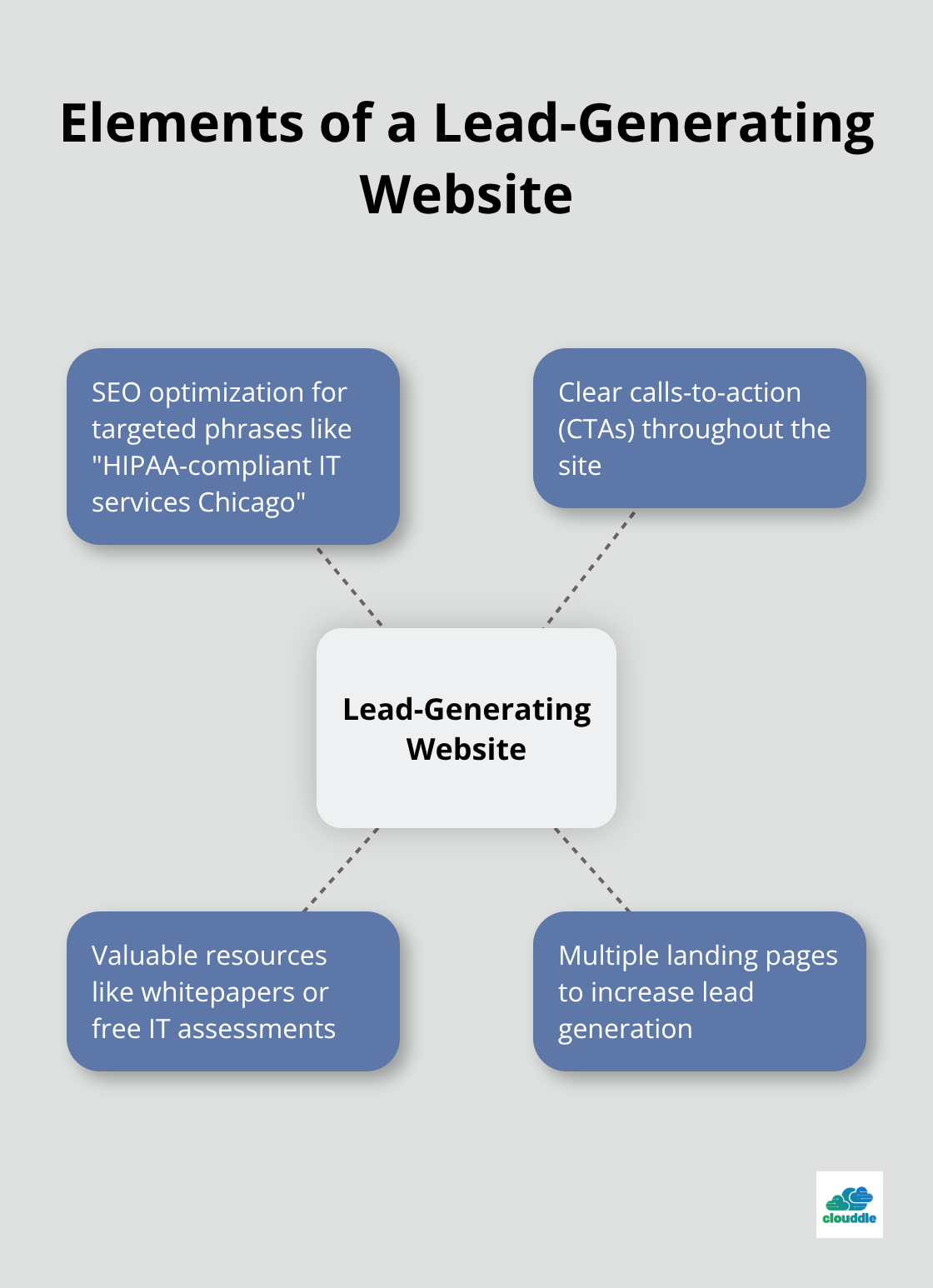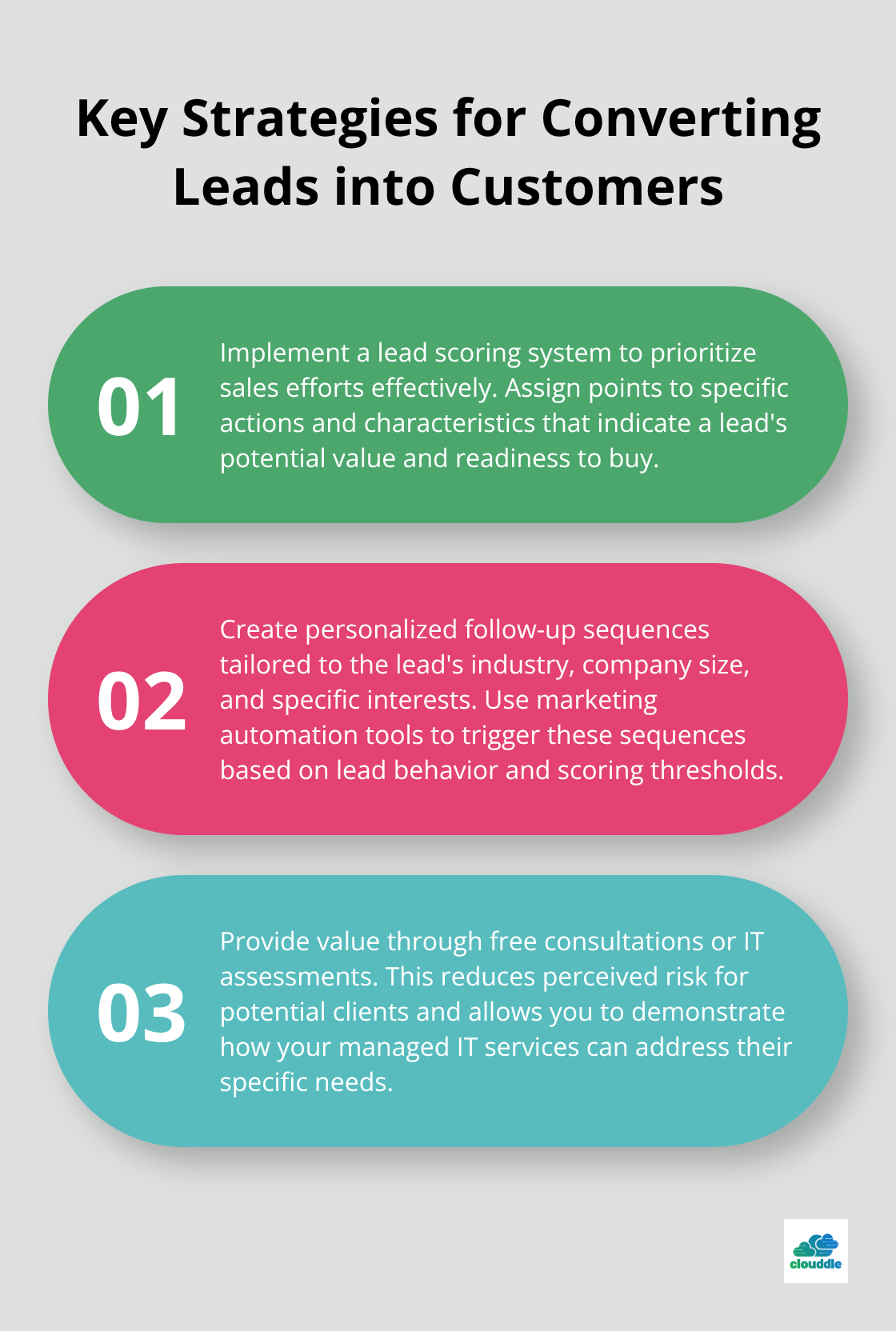Managed IT services lead generation is a critical challenge for many providers in today’s competitive landscape. At Clouddle, we’ve seen firsthand how effective strategies can transform a company’s growth trajectory.
This guide will walk you through proven techniques to attract and nurture high-quality leads for your managed IT services business. From understanding your target market to implementing cutting-edge digital marketing tactics, we’ll cover everything you need to know to boost your lead generation efforts.
Who Is Your Ideal Managed IT Services Client?
Defining Your Ideal Client Profile
The foundation of successful lead generation for managed IT services lies in understanding your target market. You should start by analyzing your current client base. Look for patterns in company size, industry, and the specific IT challenges they face. For example, if you excel at serving healthcare providers with 50-200 employees, focus on similar organizations. This targeted approach allows you to tailor your services and marketing messages more effectively.
A recent survey by CompTIA reveals that 46% of small and medium-sized businesses (SMBs) plan to increase their IT spending in the next 12 months. This presents a significant opportunity for managed IT service providers who can address the unique needs of growing businesses.
Uncovering Pain Points and Challenges
After you identify your ideal client profile, you need to uncover their specific pain points. Common challenges for SMBs include cybersecurity concerns, data management issues, and the need for scalable IT infrastructure.
A study by IBM showed that approximately 60% of small businesses rank cybersecurity risks such as phishing and ransomware as major concerns. This statistic highlights the urgent need for robust IT security services among smaller businesses.

Competitive Analysis for Strategic Positioning
Analyzing your competitors’ strategies provides valuable insights for your lead generation efforts. You should examine their service offerings, pricing models, and marketing approaches. Tools like SEMrush or Ahrefs can help you uncover their digital marketing tactics and keyword strategies.
Pay attention to gaps in the market that your competitors might overlook. For instance, if most providers in your area focus on general IT support, you could differentiate by specializing in industry-specific compliance solutions or advanced cybersecurity services.
The goal isn’t to imitate your competitors but to find unique ways to stand out in the market. Some managed IT service providers have found success by offering tailored solutions for specific industries (like hospitality and senior living), addressing niche needs that larger, generalist IT providers often overlook.
Leveraging Data for Targeted Marketing
Once you’ve gathered insights about your ideal clients and the competitive landscape, you can leverage this data for targeted marketing efforts. Use the information to create detailed buyer personas, which will guide your content creation and marketing strategies.
For example, if you’ve identified that your ideal clients are CFOs of medium-sized manufacturing companies concerned about cybersecurity, you can create content that specifically addresses their pain points (e.g., “5 Cybersecurity Threats Every Manufacturing CFO Should Know”).
With a clear understanding of your target market, their challenges, and the competitive landscape, you’re now ready to explore effective lead generation strategies that will resonate with your ideal clients and set you apart in the managed IT services industry.
How to Supercharge Your Lead Generation
Create a Lead-Generating Website
Your website serves as the first point of contact for potential clients. Optimize it for search engines by making your site interesting and useful, expecting your readers’ search terms, avoiding distracting advertisements, and linking to relevant resources. For example, if you specialize in cybersecurity for healthcare providers in Chicago, focus on phrases like “HIPAA-compliant IT services Chicago.”
Include clear calls-to-action (CTAs) throughout your site. Offer valuable resources (such as whitepapers or free IT assessments) in exchange for contact information. A study by HubSpot reveals that businesses with 31 to 40 landing pages generate 7 times more leads than those with only 1 to 5 landing pages.

Establish Thought Leadership
Position yourself as an industry expert through content marketing. Create blog posts, videos, and podcasts that address common IT challenges faced by your target market. You could produce a series on “Cybersecurity Best Practices for SMBs” or “How to Implement BYOD Policies Safely.”
Share your content across multiple platforms to maximize reach. LinkedIn proves particularly effective for B2B marketing, with 58 important LinkedIn statistics every B2B marketer should know, according to research compiled by Foundation Inc.
Utilize Email Marketing
Email remains a powerful tool for lead generation. Segment your email list based on industry, company size, or specific IT needs. This approach allows you to send highly targeted content that resonates with each group.
Implement drip campaigns to nurture leads over time. A study by Annuitas Group shows that nurtured leads make 47% larger purchases than non-nurtured leads.
Explore Paid Advertising
While organic strategies play a vital role, don’t overlook the power of paid advertising. Google Ads can put you in front of potential clients actively searching for IT services. Use retargeting to re-engage visitors who’ve shown interest but haven’t converted.
Social media advertising, particularly on LinkedIn, can yield high returns for B2B services. LinkedIn’s targeting options allow you to reach decision-makers in specific industries and company sizes.
Track and Optimize Your Efforts
The key to successful lead generation lies in consistency and continuous improvement. Monitor your results, analyze what works, and refine your strategies accordingly. Try A/B testing different elements of your campaigns (such as email subject lines or ad copy) to identify the most effective approaches.
As you implement these strategies, you’ll notice a steady increase in high-quality leads for your managed IT services. However, generating leads is only the first step. The next challenge lies in effectively nurturing and qualifying these leads to maximize your conversion rates.
How to Turn Leads into Customers
Implement a Lead Scoring System
A lead scoring system prioritizes sales efforts effectively. Assign points to specific actions and characteristics that indicate a lead’s potential value and readiness to buy. For example, a lead who downloads a whitepaper on cybersecurity solutions might receive 10 points, while one who attends a webinar could earn 20 points.
Lead scoring helps identify and prioritize high-quality leads that are more likely to convert, allowing you to allocate your sales and marketing resources more effectively. This approach allows you to focus your resources on the most promising prospects, which increases your overall conversion rates.
Create Personalized Follow-Up Sequences
High-potential leads require personalized follow-up sequences. Tailor your communication based on the lead’s industry, company size, and specific interests. For instance, if a lead from a healthcare provider has shown interest in HIPAA compliance, send them targeted content about your specialized healthcare IT solutions.
Personalized emails improve click-through rates by 14% and conversion rates by 10% (as reported by Marketing Sherpa). Use marketing automation tools to trigger these personalized sequences based on lead behavior and scoring thresholds.
Provide Value Through Free Consultations
Free consultations or IT assessments serve as powerful tools for lead nurturing. They reduce the perceived risk for potential clients, allowing them to evaluate your services without any financial commitment. During these sessions, focus on understanding the client’s unique challenges and demonstrate how your managed IT services can address their specific needs.
A survey by Demand Gen Report found that 96% of B2B buyers want content with more input from industry thought leaders. Expert advice during consultations positions you as a trusted advisor, which significantly increases the likelihood of conversion.
Use Marketing Automation Tools
Marketing automation scales your lead nurturing efforts. Tools like HubSpot, Marketo, or Pardot help you automate email sequences, track lead interactions, and trigger appropriate follow-ups based on lead behavior.
Marketing automation drives a 14.5% increase in sales productivity and a 12.2% reduction in marketing overhead (according to Nucleus Research). These tools maintain consistent communication with leads across multiple channels, which ensures that no opportunity falls through the cracks.
Offer Targeted Content
Provide valuable, targeted content to nurture leads through the sales funnel. Create whitepapers, case studies, and industry reports that address specific pain points of your ideal clients. For example, if you target the hospitality industry, produce a guide on “Enhancing Guest Experience Through Seamless Wi-Fi Solutions.”
Targeted content establishes your authority in the field and keeps leads engaged with your brand. A study by DemandGen found that 47% of buyers viewed 3-5 pieces of content before engaging with a sales rep. This approach educates your leads and moves them closer to a purchasing decision.

Final Thoughts
Managed IT services lead generation requires a strategic approach. You must understand your target market, implement effective marketing tactics, and nurture leads through the sales funnel. Your website, content marketing, and email campaigns serve as powerful tools in your lead generation arsenal. Social media platforms and pay-per-click advertising can further amplify your reach and attract high-quality leads.
Lead nurturing plays a vital role in converting prospects into clients. You should implement a lead scoring system, create personalized follow-up sequences, and offer free consultations to demonstrate your expertise. Marketing automation tools can streamline these processes, which allows you to scale your efforts efficiently.
At Clouddle, we combine cutting-edge technology solutions with a deep understanding of industry-specific needs. We offer comprehensive IT solutions that include networking, Wi-Fi, security services, and data cabling (to name a few). Our approach helps businesses focus on growth while we handle their technology needs.


